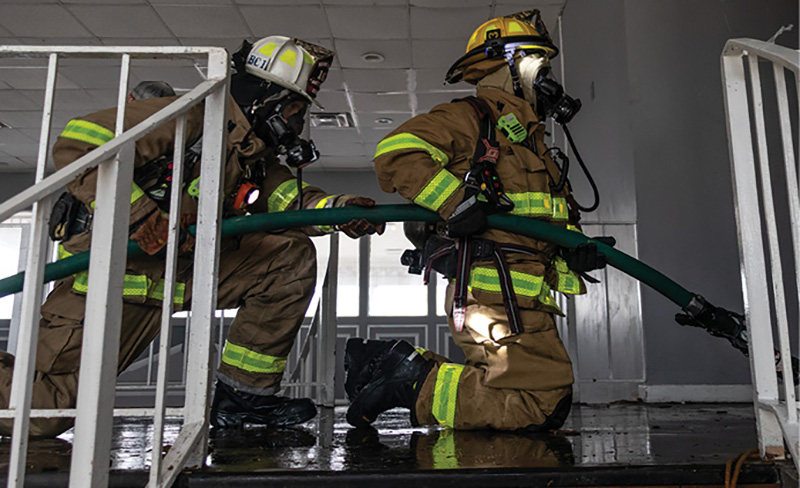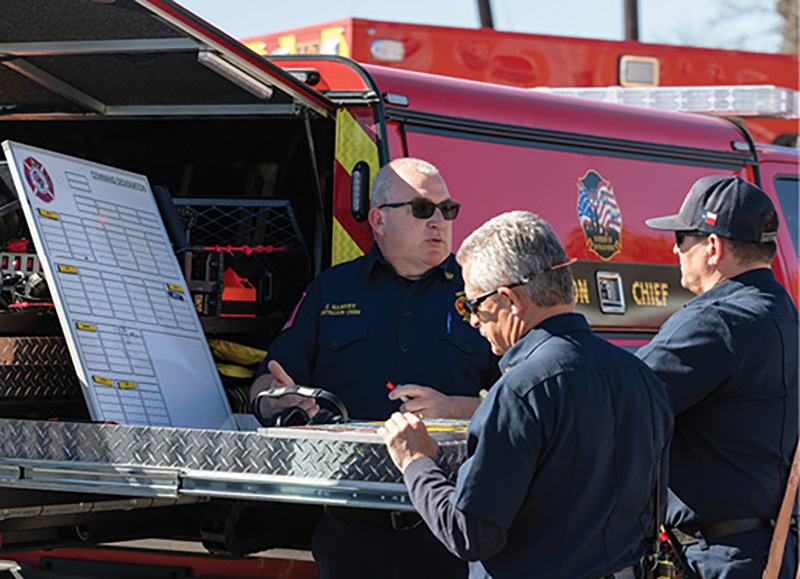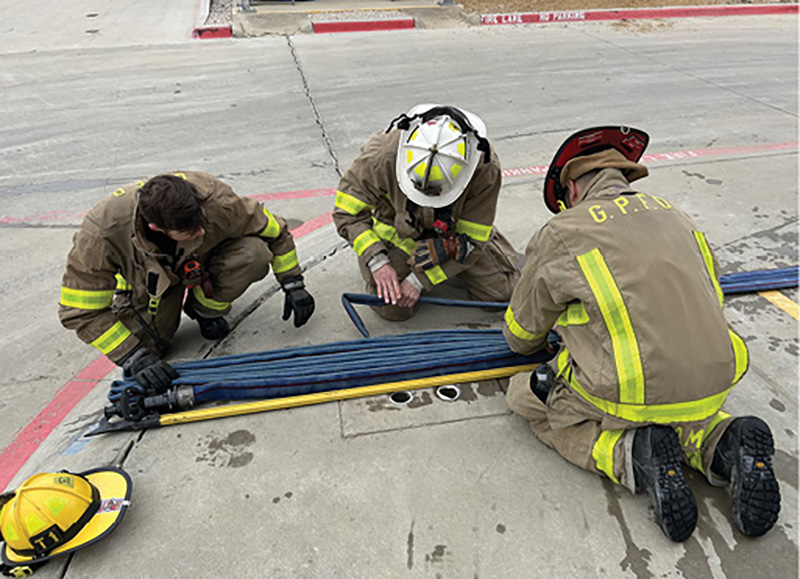
BY JAMES PURDOM
“We can’t get out.” On the fireground, no one wants to hear—or say—these words. I was the move-up battalion chief, and it was my first “good” working fire as the incident commander (IC) when I heard them. Crews had rescued a victim, but they were having trouble accessing the seat of the fire due to hoarder conditions.
Control, Command, and Communicate to Manage the Mayday
I had just ordered all crews out of the house when the extending fire trapped part of the search team. I declared a Mayday and asked the crew for their approximate location. They replied that they were in a bedroom. Safety reminded me to ask the Mayday crew to activate their personal alert safety system (PASS) devices. Immediately on activating their PASS devices, Safety heard them just inside the large window of a bedroom/study. The window was taken out and the crew quickly exited without injury. Only about three and a half minutes passed from the time they said, “We can’t get out,” until they were out the window, but in that moment, it felt much longer.
This fire and Mayday led to personal soul searching. It also led me to research both what caused the Mayday and why we were able to successfully mitigate it. I have written previously about the reasons for the Mayday and the lessons we learned from that incident. This article will focus on the main reasons we successfully mitigated the Mayday: prior training, preparation, and everyday leadership.
Prior Training
In today’s world of the Internet and social media, “training” can be just a click away. Fortunately, we’re seeing an uptick in the number of available, quality hands-on training offerings. It seems like every weekend there is a fire conference going on somewhere around the country. This enables firefighters to get outside of their local areas—and comfort zones—and learn what other people are doing. I am an active member in my local Fraternal Order Of Leatherheads Society (F.O.O.L.S.) chapter (Frontier F.O.O.L.S.), and I enjoy attending and instructing trainings.
I have learned many tricks and tips over the past few years, all of which my body wishes I learned years ago. I have seen and participated in great training sessions to keep firefighters from getting into trouble and having to call a Mayday. And I have seen some great Mayday and rapid intervention team (RIT) training. As great as this training is at the task and tactical levels, we need more quality, realistic Mayday training for the IC.
Keeping It Realistic
All too often, command training for Maydays consists of practicing on the radio or having a specific Mayday drill. Not many departments practice Maydays in higher-stress situations or as part of an entire scenario where the other fireground tasks must continue.
Numerous studies show the correlation between hormone-induced elevated heart rate and decreased decision-making ability. And nothing elevates the heart rate like the sound of a Mayday call. This is why training under realistic conditions is so important. Stress inoculation should not just be for task-level activities. It should include the IC.
Remaining calm on the radio while sitting at the station practicing a Mayday is one consideration, but trying to remain calm when your friends are trapped in a fire is a completely different scenario. You will have to make many decisions—quickly—and if you have not previously done this under duress, you will struggle in an actual Mayday. This is why ICs’ participation in training at multiple levels—from the quick, easy drill all the way to the full-scale scenario—is so important (photo 1).
Less than a year before the Mayday fire, we had an acquired structure—a former motel—for training for several weeks. We conducted multiple drills throughout that time and the training culminated with full-scale evolutions. We incorporated a Mayday into the evolution as well.
I was able to function as command tech and as IC several times, and I was able to observe multiple other evolutions to see how other people handled the situation. This training and experience made all the difference on the day of the actual Mayday. I was prepared (photo 2).
Crawl, Walk, Run
Like many before me, I believe in the “crawl, walk, run” method of training. A familiar example is forcing a door. Here’s how it breaks down:
- Crawl: Learning mechanical advantage and tool usage along with the individual steps of forcing a door.
- Walk: Repeating the steps of physically forcing a door until it becomes second nature.
- Run: Forcing a door while under stress as part of a larger scenario.
And here’s the breakdown if we’re looking at it in terms of commanding a Mayday:
- Crawl: Practicing receiving a Mayday report on the radio and then going through the steps of commanding the Mayday or walking through the Mayday worksheet on the radio.
- Walk: Conducting a RIT drill in the bay where the RIT and IC communicate with the Mayday firefighter.
- Run: Running a Mayday during a full-scale evolution. The run phase needs to incorporate the Mayday into the evolution so that the incident and the Mayday occur simultaneously.

1. Practicing commanding a Mayday. A Mayday was built into a full scenario at an acquired structure, which provided a more realistic environment. (Photos by Marina Bustillo unless otherwise noted.)

2. A battalion chief and captain participating in skills training. Having chiefs participate in skills training is invaluable for building rapport with firefighters. (Photo by author.)
A Helpful Tip
Train with people in move-up positions. If people regularly move up without training in each move-up position, their department is setting them up for failure. The day of our Mayday fire, I was the move-up battalion chief. My command tech was a move-up who had never been command tech at a working fire. One of the truck captains was a move-up, and one of the engine lieutenants was a move-up. All of us had trained in these roles, which proved valuable and helpful.
Preparation
Even if we have participated in training, we need to prepare. Preparing for service can refer to the physical act of getting gear set up in a ready state. It can also be about mental preparation. Humans are creatures of habit, so something as simple as not having gear set up in a certain way can have a domino effect on the rest of the team’s actions. The IC may not need to fully bunk out, but he must have his equipment set up and ready to go. The time of the incident is not the time to try to find a pen or a marker, and it’s not the time to try to remember how the accountability system works.
We can say the same for a person’s mental state. The list of potential mental distractions is endless. Everyone’s life extends beyond the fire department. We can’t shut those distractions out—nor should we. However, when the tones go off, neither the people calling 911 nor the emergency itself care about what is happening in our lives. The citizens want—and deserve—our best effort.
Visualization
Professional athletes often talk about visualizing specific game situations. They have mentally played out each scenario before ever being placed in those situations. This level of preparation allows them to respond as if they have been there before. In their mind, they have been. Fire Department of New York Lieutenant Mickey Farrell talks about this concept in his classes, calling it “mental rehearsal or mind mapping.”
The experience we create in our mind can offset, to a degree, the experience that we have not yet had in real life. At our incident, I did not hesitate to declare a Mayday. I was very deliberate about what I said and how I said it. Here’s why: I had visualized and rehearsed what I would do and say as well as how I would say it in that scenario. Without the visualization and rehearsal, I would not have performed nearly as well.
Information Seeking
In addition to visualization, preparing to command a Mayday also means seeking out information on Maydays. Going to classes, reading articles, and looking at real data are all ways to prepare for a Mayday. The late Don Abbott compiled real Mayday information with Project Mayday.
What we have discovered in going through the data of Project Mayday is that many of our preconceived ideas about Maydays were incorrect. There was a big focus on RIT for years, with good reason, but the statistics show that less than 10 percent of Maydays are in fact resolved by the RIT. As a result of this data, we’ve seen a greater focus on the goal of self-rescue, working with other interior crews to resolve the Mayday, and avoiding the Mayday. This development should also drive home the point that RITs should not be “yard shepherds.” Instead, they should be active (throwing ladders, softening the structure, keeping track of where crews are working, etc.).
Unfortunately, in many cases, this training does not filter up to the IC level. At the command level, we still see a tendency for firefighters to train and prepare just for talking on the radio to the Mayday firefighter and then using the RIT.
Command preparation and training must include the following critical components:
- Knowing the warning signs that often precede a Mayday.
- Having an active RIT.
- Having a plan to continue fighting the fire even while using interior crews when a Mayday occurs.
- Practicing all of the above steps under increasingly realistic conditions.
Many ICs do not have experience with running a real Mayday. This means that training and preparation are key to being ready if the time ever comes. If the IC has never thought about what he would do in the event of a Mayday or never trained on a Mayday in a stressful environment, the chances of things running smoothly and successfully are very slim.
Everyday Leadership
Along with training and preparation, the final piece of the puzzle for successfully commanding a Mayday comes down to everyday leadership. The topic of leadership is huge, not only in the fire service but throughout society. In the fire service, we talk about leadership in the context of the station or on the fire scene. I contend that leadership in the station bleeds over into leadership on the fire scene.
Competence, confidence, command presence, and trust are all built at the station level, and they are essential on the fireground. Firefighters have to be competent at the task level, company officers have to be competent at the tactical level, and command officers have to be competent at the strategic level. If anyone in any of those groups is not competent, we are sure to see big problems on the fireground.
Competence
Long before the tones go off, competence starts developing at the station level and on the training ground. Stretching a line, forcing a door, throwing a ladder, and calling a Mayday are all skills that require repetition. Commanding a Mayday also falls into this category. Something as simple as receiving the Mayday on the radio and then going through the follow-up steps needs to be repeated for anyone to become proficient. This is beneficial to both the firefighter and the command officer, as it requires them to work together and get to know each other’s expectations (photo 3).

3. A battalion chief is backing up a firefighter during an acquired structure hose training.

4. As the IC, I was on my way to check on the firefighters immediately following the successful clearance of the Mayday.
Confidence
In working together to build competencies at the station level, people become confident that they, as well as those around them, can do their job. Their confidence also develops on the fireground. As firefighters and officers fulfill their duties under fireground conditions, they become more confident in themselves and in others.
Command officers have many drains on their time. The higher a person promotes, the more administrative duties they have. As these duties pile up, a command officer may feel tempted to sit in the office and work rather than getting out and training daily with the troops.
It’s true: Command officers have additional administrative work to do. However, it’s still important for them to be part of some of their department’s day-to-day drills. If they’re not, they’ll need to rely on the fireground to create that confidence in themselves and receive it from their firefighters, and accomplishing that is a difficult task. Bottom line: If the command officer has not regularly participated in some of the day-to-day drills, the confidence between the firefighters and the command officers will be lacking.
Command Presence
Another important part of the competence of an IC, and the confidence the firefighters have in an IC, is the ever-elusive command presence. A large component of command presence on the fireground comes through in the way the IC sounds on the radio.
During a Mayday, it is critically important for everyone to remain calm. The more excited the firefighters are, the more air they use. An IC who conveys calm truly helps keep the situation under control, which allows the department to successfully mitigate the situation.
This approach helps calm the firefighters and thus preserve the most precious resource: air. If the IC has not trained and prepared to sound calm, cool, and collected under stress, he will most likely struggle to be successful in projecting that confident command presence (photo 4).
Trust
Tied to competence and confidence? Trust. The IC must trust that the firefighters can do their jobs and the firefighters must trust the IC to be able to handle the incident. If that trust is not built daily, it will fracture under stress. And there is no greater stress on the fireground than a Mayday.
If the firefighters do not trust the command officers or the command officers do not trust the firefighters, it will show on the fireground. This will culminate in either (or both) of two ways:
- Freelancing on the part of the firefighters.
- Micromanaging on the part of the IC.
Both of those are problematic. They both increase the risk of a Mayday and make any Mayday less manageable. Freelancing creates a chaotic environment, whereas micromanaging causes company officers and firefighters to fear decision making. If either one leads to a Mayday, the freelancing and micromanaging are sure to get worse when a Mayday occurs.
If the firefighters trust the IC, they are much less likely to freelance. Instead, in the event of a Mayday, they’ll operate within the incident plan.
And this works both ways. With trust, the IC also knows that the firefighters are competent, has confidence in them, and trusts that they will get the job done. In the presence of such trust, the IC does not need to micromanage. Trust leads to a safer fireground overall and to a much more calm and organized Mayday response.
Intentional engagement and relationship building by command officers with the officers and firefighters in the stations and on the training ground create the kind of everyday leadership every department needs for a safer fireground and a successful Mayday.
Prior to our Mayday, we had trained together numerous times. We had talked about what we would do in the event of a Mayday. And we had years of building trust. All these components came together for our Mayday. Our training, preparation, and some everyday leadership intersected and led to a successful outcome.
JAMES PURDOM has been in the fire service for 26 years, the past 19 of those with the Grand Prairie (TX) Fire Department (GPFD), where he is a captain. He is a member of the GPFD instructor cadre, a lead instructor for the Weatherford College Fire and EMS academies, and a member of the Frontier F.O.O.L.S. He is a licensed paramedic, master firefighter, and instructor III, among other certifications. Purdom has an associate of applied science degree from Weatherford College and a bachelor’s degree from West Texas A&M.

